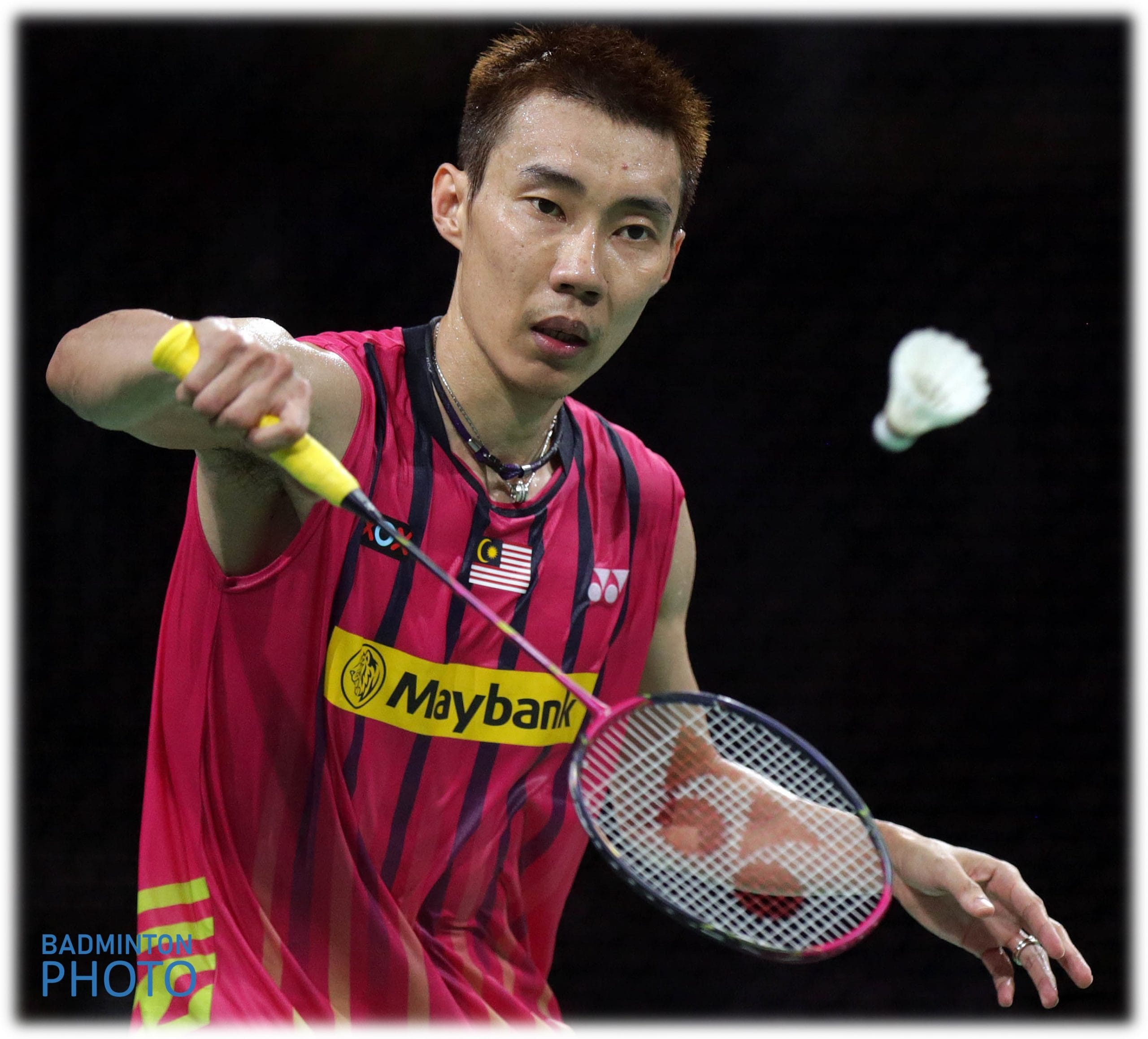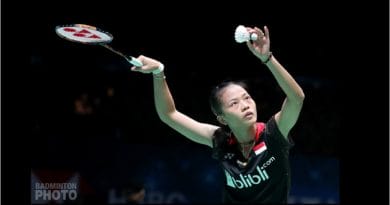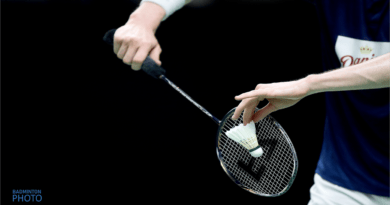6 Ways to improve your return of a singles low serve
Is there a skill to returning a low serve in singles?
What could you be considering and doing to give yourself an advantage?
How should you structure your practice to increase its effectiveness?
Returning serve is your first opportunity to win the point, influence how the rally starts, or influence the server before they serve
Do you think any of that is possible?
– – – – – – – – – – – – – – – – – –
I wonder how many of these you are already familiar with
1. The technical aspects
2. The tactical aspects
3. Prepare with intent
4. Visualise what will (could) happen
5. How to influence the server – ‘increase server tension’
6. Play lots of conditioned games – 4 examples
Advice from Badminton Insigh t
t
You can return serve without a plan if you want to,
but why would you do that?
– – – – – – – – – – – – – – – –
1. The technical aspects
Please don’t assume that if you master the technical aspects that you will become great at receiving a singles low serve. The technical aspects are only a small (but essential part) of this skill.
I’ve placed this section as the first part, so that we can establish what is required and then concentrate on the skill aspects in the other sections. The tactical ideas rely on you having established most of these technical elements, so I guess they are important, in part.
As always, there aren’t many (if any) absolute ‘must do’s’
There is plenty of scope for you to do things differently to suit how you play
Below are the 3 crucial aspects that you need to have
How & where to stand to receive
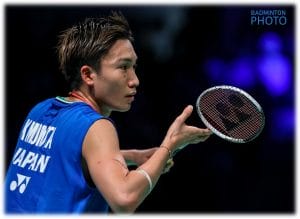 Remember that you can stand wherever you want and in whatever position you want. Therefore my recommendation is to try out different positions and certainly be prepared to adapt as you improve.
Remember that you can stand wherever you want and in whatever position you want. Therefore my recommendation is to try out different positions and certainly be prepared to adapt as you improve.
If you want to become great at receiving a singles serve you need to be positioned so that you can ‘pressure’ the server, your opponent. So stand close enough to the service line that you can do this. How close….? Now that is the question.
I recommend that you need to be in a position that when you lunge (bring your rear leg forwards) that you are striking the shuttle at least over the service line, if not a little closer to the net. You don’t have to stand as you would in doubles, beware of the flick!
So that’s where to stand, how to stand is even more important, so read on!
Preparing to move
 You must “Load Your Legs!”
You must “Load Your Legs!”
That is almost all you need to know and do, be prepared to move quickly, fast, with speed. However you describe it, just be prepared to do it.
It’s vital that not only should you load your legs with power but you show that to your opponent. Have you thought about preparing your legs as if you were about to squat in the gym, gripping or ‘ripping’ the floor (the court). Ok, the stance will be completely different but the ritual could be very similar.
You could also use your eyes to show the opponent that you are ready to move fast or that you are ready to ‘pounce’ on them! Hopefully, that idea was something that you already knew and had been doing.
Your racket
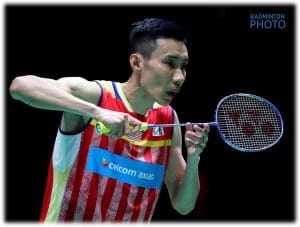 This is so obvious that you may skip this section, but it’s a very important element. It’s vital that not only should you prepare it so that you can use it quickly but that you let your opponent know that you are ready to use it.
This is so obvious that you may skip this section, but it’s a very important element. It’s vital that not only should you prepare it so that you can use it quickly but that you let your opponent know that you are ready to use it.
Look at these pictures and think about the impact they would have on you if you had to low serve in singles against these players.
– – – – – – – – – – – – – – – –
2. The tactical aspects
I believe that the return of service is a highly tactical situation.
Possibly not everyone will agree with that as they believe that it’s just the start of a rally.
What do you think – how tactical is receiving service in singles?
There are so many choices (options) for the receiver to think about making, these happen in the form of your thoughts. Hopefully, you have used the previous rally break to start your planning. Click here to read about 6 Ways to use the Rally Break
Are you prepared to consider these points during your ‘preparation’?
All these thoughts go through a players mind before returning
- How aggressively should I stand?
- Where am I likely to play my first stroke?
- Shall a spin or not – a very important thought!
- If I get a choice do I prefer to receive with my backhand ?!
- What margin for error shall I give myself, or is it an opportunity to gamble?
- How do I want the next 3 shots to ideally work out?
- How do I want to appear to my opponent, what would I like them to believe about my intentions?
- How does my opponent look, feel to me, can I use what I see/feel to my advantage?
- What returns have worked positively previously to set up the early part of the rally?
- Is this score a trigger for me to try and do ……. (you decide what)
What other thoughts do you consider or coach ?
Why not email me with some to contact@badmintonady.com
– – – – – – – – – – – – – – – –
3. Prepare with intent
“Help your players to prepare with intent“, was the advice given to me by my mentor coach.
I didn’t realise what he meant or the full impact until years later.
My challenge was how to coach this to my players, not just by talking to them but by creating situations that enabled them to experience, reflect and develop. It certainly was different to helping them improve technically!
I later found that there wasn’t a ‘best way’ but it certainly had to be a combination of experiences (for them and me): doing, reflecting, listening, asking, you could probably add more.
My best coaching efforts came in finding the ‘prompts’, the questions, and situations to help players. However, the biggest player improvements came from them seemingly taking charge of what they did on the court when receiving.
The players that seemed great at receiving serve looked like they ‘knew’ what they were doing.
It’s hard for me to tell you how to have ‘intent’ when you prepare,
but I know that you need to!

– – – – – – – – – – – – – – – –
4. Visualise what will (could) happen
The gap between rallies is there to be used, why wouldn’t you not use it!
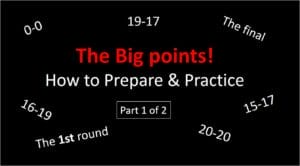 Of course, there are many things you could do and think about during the interval. In this post, we will consider aspects concerned with returning the opponents serve.
Of course, there are many things you could do and think about during the interval. In this post, we will consider aspects concerned with returning the opponents serve.
I presume that unless it’s the first rally of the match, you have realised that you would have lost the last point. If you click on this image there will be some advice to try to prepare your mind and put you in a state that you are ready to action the following ideas.
Create a thought, a picture, a plan: “Steady or Go?”
Before you take up your stance are you able to at least picture what serve you hope your opponent will deliver to you and how you want to return it. It’s important and vital to picture something.
Add to this how you wish to feel. Here are two simple words that describe two opposite feelings, but both can be positive.
In Part 6 there are some conditioned games that will allow you to experience and try out these mental states.
Put yourself in a “Go” state? You have decided that you are going to be aggressive in the sense that you want to dictate what is going to happen next, say within your next 2 strokes. This may mean being or looking super aggressive (they are not the same) or it may mean that you are prepared to work hard to retrieve all the shuttles that come back. Possibly taking a few risks, but being comfortable with that.
Or is this a moment to be “Steady”? You decide that you need to relax a little, yet still be ‘switched on’ to whatever your opponent may do. However, you will be careful over your choice of strokes, you are determined to keep the shuttle inside the court. Your mindset is determined not to give your opponent any ‘easy’ points. If you see this as a defensive mindset that is up to you. However it is not a defeatist mindset, there is a big difference!
You may find it mentally tiring visualising what could happen
It’s a skill that needs to be developed alongside all your racket skills that you are about to use
– – – – – – – – – – – – – – – –
5. How to influence the server – “increase server tension”
This is legal and I’m not suggesting that you verbally abuse your opponent. Just let them see that you are ‘ready to play’.
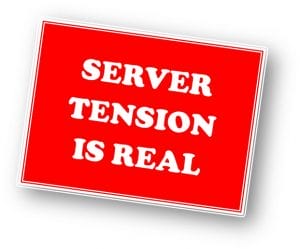 It is important that you realise that the server can be influenced and you will be part of this. Of course, you may know this already and if you do, please let me know if you agree with these points.
It is important that you realise that the server can be influenced and you will be part of this. Of course, you may know this already and if you do, please let me know if you agree with these points.
Are you doing these things?
(Have you been looking at the photographs in this post?)
- Take up a stance that shows you are ready to play: legs loaded with power as if you are ready to pounce.
- Make eye contact: let them see that you are ready and have a play, can you transmit that through your eyes?
- Have your racket ready: it doesn’t have to be like your doubles return of serve racket position, but it’s important that it looks like a threat.
- In every rally approach the shuttle “As If to…” : as if to play a net shot, … as if to play a flick, … as if to rush the attack, (you decide).
- Prepare traps and doubt: can you use what you have done in previous rallies and lay a trap for the opponent. From the start of the match ensure that the opponent sees and feels how you prepare to receive service, the way you move towards the shuttle, and the strokes you play. Then at crucial scores, you can decide if you wish to use this as a ‘bluff’ and then do something different. Or, take up a slightly different preparation and let them see this, what will they now be thinking?
- How fast can you move forwards to the shuttle: have you been practising an aggressive approach towards the shuttle. You don’t have to strike from in front (you could) but you can also then delay the moment of striking.
– – – – – – – – – – – – – – – –
6. Play lots of conditioned games – 4 examples
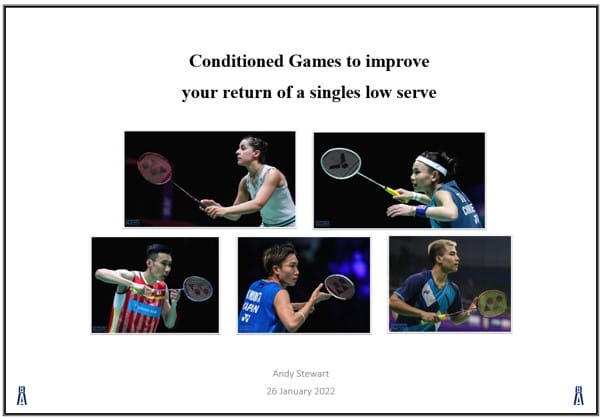
Be deliberate/aggressive in thought, preparation and action whenever you practice your receive of a low serve in singles.
Always practice with an opponent or practice partner that will serve and play at least their next 2 strokes as if it was a competitive match. It’s very important that in practice you are both motivated so that you act as if you are both playing a real game.
Of course, you and they can run through a series of scenarios that you want to explore together first. However, it is only with both players being committed to the actions and thoughts that you’d have in a real match that you can test if you are developing.
Click on this image to read and then download some ideas for conditioned games to try.
– – – – – – – – – – – – – – – –
Advice from Badminton Insight
In this video Jenny & Greg share 6 of the best return of serves you can do in singles, from both the low serve and high serve!

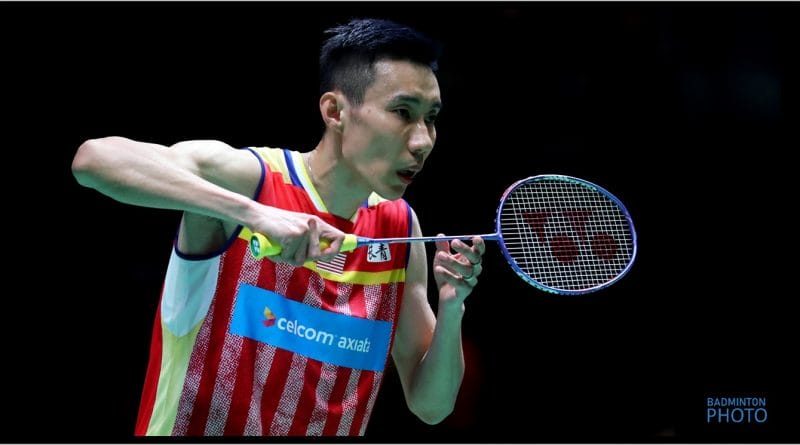
 t
t